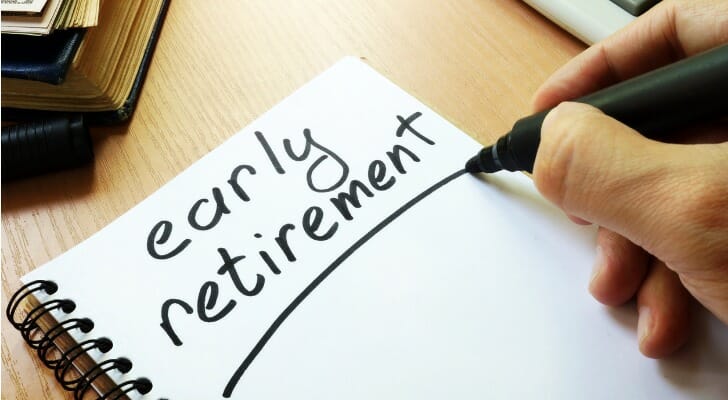Dreaming of financial freedom decades before your peers? Learning how to retire at 30 isn’t just a fantasy—it’s a mathematical possibility with the right approach. Most people work into their 60s, but a group of young retirees shows that disciplined saving, smart investing and intentional living can allow you to leave work much earlier. It takes more than traditional retirement advice. Early retirees often combine high saving rates with investment strategies built for a long retirement.
Consider working with a financial advisor as you plan and save for retirement.
Make a Clear Plan for the Future and Follow It
The first step is developing an honest estimate of how much you will need. That process entails thinking about your estimated longevity, your preferred lifestyle and getting as specific an estimate as possible for how large your nest egg needs to be.
Consider Your Life Expectancy
The current average lifespan of an American woman is 80.2 years and 74.8 years for the American male, according to the Center for Disease Control and Prevention (CDC). In other words, the average person only has to cover between 10 and 15 years worth of spending if they retire at 65. But a woman retiring at 30 needs to stretch her savings for more than half a century. A man who retires at the same age needs to be able to pay for nearly 45 years.
Account for Your Lifestyle
Next, figure out the lifestyle you would like to enjoy for that half century. For example, do you want to pursue the same hobbies and passions you do now? Do you intend to or want to be able to travel, buy the latest electronics or take classes—or all of the above? What kind of insurance protection will you want and what kind of mortgage or rent do you want to be able to afford? Your vision for the future will determine how much you need to save.
Run the Numbers
When planning how to retire at 30, determining your “magic number” is crucial. Financial experts typically recommend multiplying your desired annual income by 25-33, depending on your withdrawal strategy. This calculation becomes even more important for early retirees who face decades longer in retirement than traditional retirees.
For those with a 50+ year retirement horizon, the traditional 4% withdrawal rule may be too aggressive. A more sustainable approach might be 2.5-3%. At a 3% withdrawal rate, you’d need approximately $1.7 million saved to generate $50,000 in your first year of retirement. For a more comfortable $100,000 annual income, your target grows to around $3.4 million in savings.
Strong early retirement plans build in buffers for unexpected expenses. Consider adding 15-20% to your calculated number to account for healthcare costs, family emergencies or extended market downturns. This might mean aiming for over $4 million in savings instead of the $3.6 million target.
Don’t Forget About Inflation
You’ll need a portfolio that holds up through market cycles and decades of inflation. What costs $50,000 today might require $90,000 in 20 years at just 3% inflation. Your investments should generate income and keep growing to maintain purchasing power over time.
Cut Your Expenses

Unless you just won the lotto or are an investing genius, you’ll have to cut costs to get your expenses within the range necessary to accumulate your target savings amount. Here are some ways you can cut your expenses to expedite your savings journey:
- Start with debt: Focus on cutting or eliminating interest and principal payments.
- Live within your means: Think about living with roommates or switching to public transportation. Reassess how much clothing you need and maybe dial back your desire for a fashion-forward wardrobe.
- Find the cheapest way to meet your needs: Many people turn to the Affordable Care Act’s (ACA) marketplace to buy coverage. But you also have the option of private health insurance, which may make more sense depending on your needs. Food co-ops may also be a way to cut grocery expenses.
For those pursuing the FIRE (Financial Independence, Retire Early) movement, controlling expenses is just as impactful as increasing income. A lower cost of living reduces the amount of money needed to reach financial independence and decreases the size of the portfolio required to retire early.
Maximize Your Savings
The above steps will help you top up your savings. You can also try other ways to increase savings, including:
- Taking advantage of your employer’s matching 401(k) contributions
- Maxing out your own 401(k) contributions
- Using high-interest savings accounts, like CDs and money market accounts
- Taking advantage of cash back opportunities
- Automating your savings
- Aiming for a raise while you’re still working
- Reducing your taxable income by using credits and deductions
- Regularly increasing your savings rate as your income grows
- Getting a second job and saving every dollar you get from that job
Boost Your Income
Think of your average 9-to-5 job that provides earned income. The IRS calls this type of work “material participation,” and it includes any operation you engage with on a “regular, continuous and substantial basis.” There are several criteria that determine whether a project or job counts toward material participation, like working over 500 hours. But you want to shift away from this in retirement. That leaves you with passive income-generating options.
Make sure the fixed-income portion of your portfolio is adequate, both in terms of appropriate asset allocation and in terms of actual income generated. Some examples of passive income-generating assets include:
- Annuities
- Dividends from securities
- P2P lending
- Rental properties
Even certain side hustles qualify as passive income, like self-publishing an e-book.
Bottom Line

Many workers are turning to financial freedom movements like FIRE. Through it, they see a future they’re in control of – not the money they need to earn. But even if you are happy to work through your 30s or even 40s, the above steps can give you a head start toward a financially secure future. Things like maximizing your savings and paying down debt will help you achieve your goals no matter your retirement age.
Retirement Planning Tips
- Retirement planning on a traditional timeline is hard enough. Getting there early may require additional guidance from a financial advisor. Finding a financial advisor doesn’t have to be hard. SmartAsset’s free tool matches you with vetted financial advisors who serve your area, and you can have a free introductory call with your advisor matches to decide which one you feel is right for you. If you’re ready to find an advisor who can help you achieve your financial goals, get started now.
- A big part of retirement planning is finding the right numbers. You need to know how much you should save to keep yourself afloat. Retirement calculators and Social Security calculators make it easier to estimate how much money you’ll need in retirement.
Photo credit: ©iStock.com/designer491, ©iStock.com/Viktor_Gladkov, ©iStock.com/courtneyk
